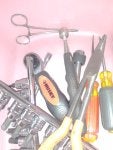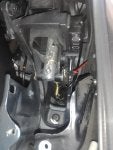I finally swapped out the LOAD ASSIST cylinders. The trick is to move the roof panel back until the upper pin going through the load assist cylinder raises high enough to push it inboard. Check that you have clearance to push the pin before you do anything else.
You must remove the panels above the load assist cylinder at the rear quarter window to access that upper pin. Raise the rollbar for pin clearance. Then move the vario roof rearward for the pin to clear when pushed inboard. I use a pair of needle nose hemostats to remove the pin’s gold clip.
If you can’t get that upper pin pushed inboard enough to pull the clevis on top of the cylinder rod forward, you may need to remove the interfering panels.
To remove the lower torx 30 bolt/screw that goes through the bottom of the load assist cylinder: Raise the rollbar. Remove 3 bolts per rollbar support assembly – 1 bolt at the top of the support assembly that connects to the rollbar.; 2 bolts at the bottom. Disconnect the wire from the right support assembly. Remove the right and/or left support assemblies to expose the rubber plug covering the entryway hole to the torx 30 bottom bolt.
With the upper pin disconnected, and top of the cylinder rod loose and pulled forward, I push the roof forward, which loosely compresses the cylinder. I unscrew the bottom bolt most of the way, and insert a magnet on a stick to pull the bolt out. You now can pull the cylinder forward from above and lift it out.
Push the only hydraulic new hose back along the path of the original old hose, and connect it at the hydraulic pump.
Drop the bottom of the new hydraulic load assist cylinder into it’s hole. Loosely tighten the torx 30 bottom bolt. Push the top clevis into position to reinsert the top pin. If needed, pull the top rearward to raise the upper pin hole. Insert the upper pin, and secure it with the gold clip. Tighten the lower bolt.
Above you see tools I used including the needle nose hemostats stuck to the magnet on a stick.









